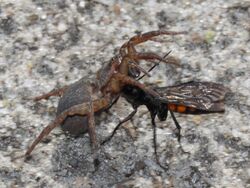Biology:Trochosa terricola
| Trochosa terricola | |
|---|---|

| |
| Scientific classification | |
| Domain: | Eukaryota |
| Kingdom: | Animalia |
| Phylum: | Arthropoda |
| Subphylum: | Chelicerata |
| Class: | Arachnida |
| Order: | Araneae |
| Infraorder: | Araneomorphae |
| Family: | Lycosidae |
| Genus: | Trochosa |
| Species: | T. terricola
|
| Binomial name | |
| Trochosa terricola (Thorell, 1856)[1]
| |
| Synonyms[2] | |
| |
Trochosa terricola is known as the ground wolf spider,[3] is a wolf spider which is common and widespread in western and central Europe.[1] It has been recorded as prey for the pompilid wasp.
Description
Male Trochosa terricola are 7–9 mm in length while females are 7–14 mm.[4] Similar in appearance to other Trochosa species, the female T. terricola has a reddish abdomen while the male has darkened front legs. The two short lines which are visible on carapace are a diagnostic feature of Trochosa wolf spiders. The light cardiac mark separates it from Trochosa ruricola which has a dark cardiac mark.[5]
Habitat
Trochosa terricola is found in woodland, grassland, heathland and industrial sites and is often encountered under stones and logs, but overall it shows a preference for drier, heath-like conditions, although has been found in pitfall traps in areas of bog and marsh. Unlike the related T. ruricola it can be common in upland areas.[1]
Biology
Adults, both males and females, have been recorded from March to November, with a peak from spring to mid-summer,[1] although in warmer areas in can be active throughout the year.[3] This spider generally appears more sluggish than the Pardosa wolf spiders with which it is sympatric.[3] T. terricola is normally most active at night.[4] It has been recorded as a prey item of the pompilid wasps Priocnemis perturbator and Anoplius viaticus[6]
Distribution
Holarctic,[2] in Europe it is found throughout the continent and Great Britain and Ireland but is absent from Iceland.[4]
References
- ↑ 1.0 1.1 1.2 1.3 "Summary for Trochosa terricola (Araneae)". British Arachnological Society. http://srs.britishspiders.org.uk/portal.php/p/Summary/s/Trochosa+terricola. Retrieved 3 September 2016.
- ↑ 2.0 2.1 "Taxon details Trochosa terricola Thorell, 1856". World Spider Catalog. Natural History Museum Bern. http://www.wsc.nmbe.ch/species/21060. Retrieved 2016-09-03.
- ↑ 3.0 3.1 3.2 "Trochosa terricola". Stefan Sollfors, Eurospiders.com. http://eurospiders.com/Trochosa_terricola.htm. Retrieved 3 September 2016.
- ↑ 4.0 4.1 4.2 "Trochosa terricola Thorell, 1856". Nentwig W, Blick T, Gloor D, Hänggi A, Kropf C: Spiders of Europe. www.araneae.unibe.ch.. http://www.araneae.unibe.ch/data/1208/Trochosa_terricola. Retrieved 3 September 2016.
- ↑ "Trochosa terricola". NatureSpot. http://www.naturespot.org.uk/species/trochosa-terricola. Retrieved 3 September 2016.
- ↑ Edwards, R. & Telfer, M.G., eds. 2002. Provisional atlas of the aculeate Hymenoptera of Britain and Ireland. Part 4. Huntingdon: Biological Records Centre.
Wikidata ☰ Q1757795 entry
 |


